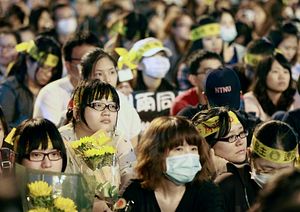A week or so ago, in the southern city of Tainan, a political rally unfolded in one of the city’s many public parks. It attracted a sizable crowd of young people, a not uncommon sight since the Sunflower Movement, with its legions of sunflower adorned youth protesting the Cross-Strait Service Trade Agreement (CSSTA), burst onto the scene in late March. Here, too, vivid displays of sunflowers abounded—but something was different. This time the discussion was about Taiwanese independence.
The forum was a spin-off from a recent sub-movement, which goes by the name “big intestine flower” (大腸花), a purposefully comical play on the Chinese characters that make up the Sunflower Movement (太陽花). As its name suggests, it is a less savory, blunter form of the Sunflower Movement, which many felt was too choreographed, polished and polite towards a biased media and callous government apparatchiks.
In recent weeks, the movement and local spin offs, like the one in Tainan, have been hosting evening “talk trash” forums across Taiwan, where anyone can take the microphone and fulminate against whoever they deem worthy. The forums are lively and profanity-filled, and often stretch into the early hours of the morning. At an initial forum in Taipei, Lin Fei-fan, one of the Sunflower Movement’s leaders, who achieved celebrity status during the occupation, was in attendance, and received a thorough roasting by a friendly, but fed-up crowd.
When the Sunflower Movement occupied the Legislative Yuan last month, many observers approvingly noted the difference between the Taiwanese youth’s occupation and the one that emerged in New York City in 2011, which shunned leadership structures in exchange for “collective decision-making,” and which ultimately fizzled out under the weight of its own incoherence. The Taiwanese students immured in the Legislative Yuan were, by contrast, organized and disciplined. They had a centralized decision-making process, charismatic leaders and a clear, unified message.
This last was the most refreshing of all. Diverse and radical sub-messages muddled Occupy Wall Streets’ central theme of income inequality and banker privilege, hemorrhaging the movement’s vitality as it encountered heavy-handed police tactics. In many ways, the Sunflower Movement’s enormous success in winning the battle for public approval against President Ma Ying-jeou and the country’s powerful pro-KMT media was due to its ability to make effective and pragmatic decisions about strategy and message.
However, since leaving the Legislative Yuan, the Sunflower Movement has undergone something of a transformation, as it confronts the pent up frustration of its supporters, many of who disagreed with their leadership’s tactics, or its decision to evacuate the chamber after President of the Legislature Wang Jin-pyng swept in and promised to address the students’ demands. This collective release among the rank and file is allowing a number of previously latent milieus and aspirations, like independence, to boil to the surface.
The Sunflower Movement now suffers not from a lack of an objective, but from too many. Even though its the original aim, countering the trade pact, hangs by the thread of one politician’s promise, activists, energized by newfound momentum, have shot out in disparate directions to address various causes, while the movement itself takes on an awkward supporting role. First, the Sunflower Movement fell in behind protesters enraged over the police eviction of Alliance of Referendum for Taiwan, a pro-independence group, from the site of the Legislative Yuan. Soon after, it rallied behind activists in Miaoli protesting a development project that threatened an endangered leopard’s habitat. These minor excursions were preparation for a much larger one, as the anti-nuclear movement, readying a major offensive, began to latch on to the Sunflower Movement.
The Sunflower Movement originated by harnessing the organizational capabilities of decentralized, grassroots activism that straddle a broad range of issues. Taiwan’s activist scene comprises a diverse set of groups, which have often been able to mobilize loosely around broad civic ideals and objectives, although they rarely reach wholehearted consensus. In this sense, the sweeping discipline of the Sunflower Movement was a notable anomaly, a product of locality and happenstance, since the activists that ended up inside the Legislative Yuan set the agenda for those outside. It’s thus hardly a surprise that ever since exiting the protective keep of the Legislative Yuan, the movement has reverted to its natural, decentralized form, even while its energy remains.
Of course the movement’s growing disjointedness threatens to dilute its original message. Tense standoffs between protesters convulse Taipei almost daily, but what is being protested changes day to day. The Sunflower Movement was unique in its ability to cut across demographics, ethnic cleavages and ideological dispositions with its carefully tuned civic message. As the movement takes on more and more issues, will it lose its broad appeal?
And what about radicalization? Tellingly, the “big intestine flower” forums arose from events that the Jianmin Liberation Zone, a Sunflower Movement splinter, began hosting during the occupation. The group was among the first to voice dissatisfaction with the Sunflower Movement’s tactics, and broke off midway through the occupation, turning to Occupy Wall Street style “direct democracy” meetings instead. Could the spread of these open forums serve as a vehicle for radicalizing a movement increasingly exasperated with the Ma administration’s constant prevarications and rebuffs?
Possibly. On the other hand, the Sunflower Movement’s most recent transmutation is a powerful agent of democracy. Every night various open forums and teach-ins can be seen on street corners and public squares in most major Taiwanese cities. Some feature stages, turntables, and blaring audio systems, some just flimsy plastic stools and a microphone, and others still simply a crowd huddled around a vacant space enraptured in discussion. The overarching objective of these initiatives is to awaken Taiwan’s civic consciousness. The Sunflower Movement’s goal was always larger than merely opposing CSSTA; it sought to achieve a true civic awakening. With this in mind, perhaps, relinquishing control over tactics and message is the best strategy of all.
Lorand C. Laskai is a freelance writer based in Tainan, Taiwan.

































